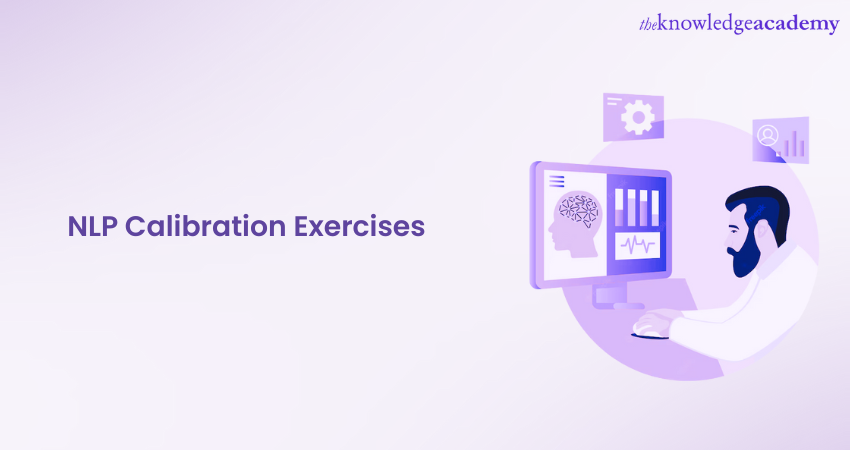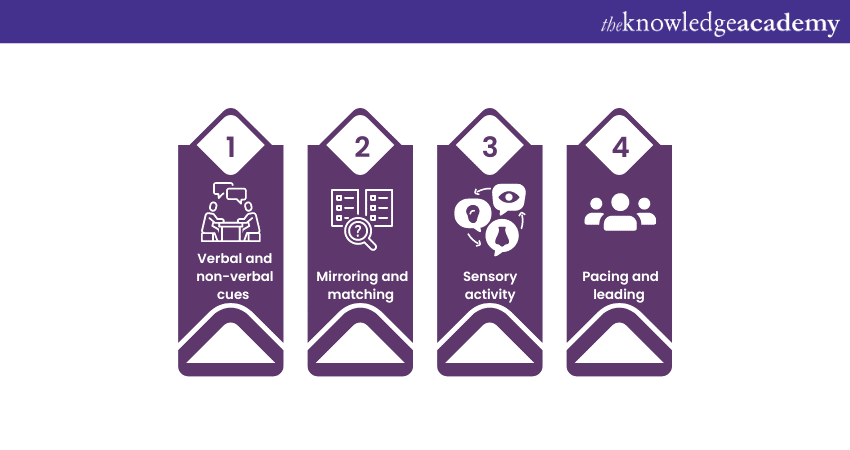We may not have the course you’re looking for. If you enquire or give us a call on +971 8000311193 and speak to our training experts, we may still be able to help with your training requirements.
Training Outcomes Within Your Budget!
We ensure quality, budget-alignment, and timely delivery by our expert instructors.

In recent years, Neuro-Linguistic Programming (NLP) has emerged as one of the ways through which communication skills can be improved. NLP Calibration Exercises are an essential aspect of effective communication and building rapport. It involves perceiving and interpreting verbal and non-verbal cues to gain insight into a person's internal state and match their communication style.
Individuals can enhance their Communication Skills and establish better connections by understanding Calibration in NLP. This blog gives a clear understanding of NLP Calibration Exercises, which can help you tune your behavioural expressions. Keep reading to learn more!
Table of Contents
1) The importance of NLP Calibration in communication
2) What are some NLP Calibration Exercises?
a) NLP Calibration Exercise of guessing
b) NLP Calibration Exercise with pencil
c) NLP Calibration Exercises with coin
d) NLP Calibration Exercises with non-verbal responses
3) Conclusion
The importance of NLP Calibration in communication
NLP Calibration plays a vital role in communication as it enables individuals to interpret the underlying meaning behind words and gestures accurately. It helps to establish rapport, build trust, and ensure effective understanding between two or more individuals. When Calibration is employed, miscommunications and misunderstandings are reduced, leading to more successful interactions and improved relationships. For instance, NLP Dissociation Techniques can be used to gain perspective and improve communication outcomes.
What are some NLP Calibration Exercises?

NLP Calibration is supposed to be subtle in everyday activity and it is supposed to be instantaneous. Mastering this is bound to take some time and practice, but certain exercises can be extremely helpful for NLP Practitioners when it comes to getting a hold of calibration in Neuro-linguistic Programming.
There are some common NLP Calibration Exercises which can be performed with a person you know. These exercises can help you establish confidence in your yourself and integrate NLP practices in your everyday life. More importantly they act as testing grounds before you use calibration techniques in real world. Some of these common exercises are as following:
NLP Calibration Exercise of guessing
This exercise includes guessing or predicting a person’s thoughts or predictive their statements. This exercise can help you establish and understand a coherent language flow while also enhancing your ability to anticipate what the speaker is going to say. The steps for this exercise are as follow:
1) Understanding others: Start by asking your friend or partner in the exercise to visualise something. It is important whatever your partner imagines; they have a clear understanding of it for the exercise to work. You can learn more about this process in NLP Dissociation Techniques.
2) Observing physiology: Observing the physiology of your partner is a vital part of this exercise. Their body language, their facial expressions, postures, and movements will help you read what they are thinking about.
3) Acknowledging confusion: This step is a direct opposite of the first step, as you are required to discuss something which confuses your partner. This subject need to be about a topic which they barely understand or have no understanding of. It is also important that you have a firm understanding of what they ask you to explain.
4) Observing again: You need to once again on the physiology of your partner in the exercise. Look how they behave differently compared to before, how the eye moment and body language has changed from the first time.
5) Selecting concept: This step act as a verifying process for this exercise, as your partner gets to select the topic with no criteria. As a result, the topic selected by your partner can be either confusing to them or they have clear understanding of it. Only your partner will know what they have thought off, as they are not supposed to tell it to you.
6) Observing again: Lastly use your reference from how your partner react previously and analyse their body movements. This will permit you to narrow the potential things going through their head into two categories. Based on their similarities to either of previous reactions, you can assume if it is a comfortable or an uncomfortable thought.
NLP Calibration Exercise with pencil
The pencil exercise for NLP Calibration is usually done in a group of two, and it helps you refine our linguistic abilities. This exercise focuses on being physically descriptive about characteristics of an object or state of a situation with as much detail as possible. The step to this exercise is as follows:
Step 1: First person of the group is supposed to in a manner that it is about to fall of their hand. Ideally there should be sometime between the moment you let go of the pencil and the moment the pencil actually falls.
Step 2: The second person is supposed to position themself in a manner so they can prevent the pencil from falling. Ideally there you should be close enough to the pencil to react instantly but not enough to catch it effortlessly.
Step 3: The first person tries to give cues which suggests that the Pencil is about to fall. This help second person prepare for the falling pencil and prevent it from falling it to ground.
Step 4: The second person tries to read the cues of first person, which suggests that the pencil might be about to fall. The end goal of this exercise is to make sure both parties can deliver and understand the message of another person.
Want to transform your life with NLP? Sign up for our NLP Foundation and Practitioner Training Course today!
NLP Calibration Exercises with coin
This exercise for NLP Calibration relies on the use of a coin, as the name would suggest. In essence it is a very simplified version of the guessing exercise which was discussed previously. For starter, this exercise has two core parts, and both are divided as per the two participants of this exercise as mentioned below:
1. First person: First person is expected to take the coin in his hand, put the hands behind their back and shuffle it. You might find this familiar if this reminds you of games you used to play as a kid without friends, and you are not wrong. You are expected to shuffle the coin between your hands so people in front of you will not know which hand has the coin. Once confident that people in front of you cannot guess it easily, bring both of your hands forward in same manner and ask other person to guess which hand has the coin.
2. Second person: Second person’s role start once the first person pulls out their hands from behind their back. Analyse the body language of first person and try to determine which hand has the coin. Unlike guessing exercise for calibration this is essentially a competitive exercise, hence first person is not supposed to help you. Notice the tension in both hands and try to guess which hand is likely to have the coin. But also understand first person may create fake muscle tension to trick you into choosing wrong hand.
NLP Calibration Exercises with non-verbal responses
This NLP calibration exercise can help you draw the connection between internal thoughts and the physiological reaction of a person. The goal of this exercise is to help you understand that mind and body are connected to each other, and how so. The steps for this exercise are as follows:
1) Step 1: The first step of this exercise begins with the first person asking a question to the second person. The rule for this step is that the answer can be relatively simple,; hence it can be a yes or no for the sake of simplicity.
2) Step 2: Once you are done asking the question and the second person starts responding, observe their behaviour carefully. Notice the physiology of the second person and understand how their body posture and movement change based upon this answer. You should be able to draw a parallel between the answer and the body language.
3) Step 3: Repeat the process of asking a question the same, as before, however this time, the second person does not have to answer the question. The second person can just think the question in their mind, so they have a coherent understanding of the answer.
4) Step 4: Based upon the last response of the second person, the first person is supposed to guess if the answer was yes or no as before. Understand if the body language of the second person matches their previous one during the previous response.
5) Step 5: This process can be reversed, and the first person can be the respondent, and the second person can be the one to ask the question. Taking turns in this manner will help both people in the exercise grow and understand each other better. The learning gained from this can also be applicable to real life with enough practice.
Take control of your mind and transform your life with NLP by joining our Neuro-Linguistic Programming Courses today!
Conclusion
NLP Calibration Exercises are an essential skill for effective communication and relationship-building. By mastering the art of Calibration, individuals can enhance their ability to understand others, establish rapport, and build trust. Whether in personal or professional relationships, the application of NLP Calibration techniques can lead to more successful interactions and meaningful connections.
Unlock your potential and master the art of NLP by joining our comprehensive NLP Training Courses now!







 Top Rated Course
Top Rated Course




 If you wish to make any changes to your course, please
If you wish to make any changes to your course, please


